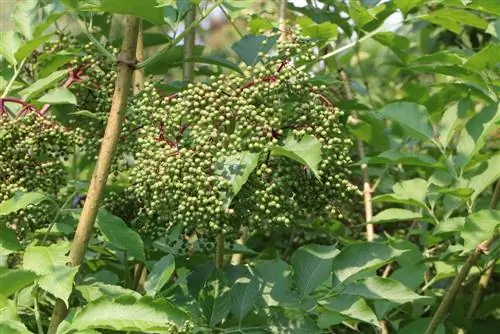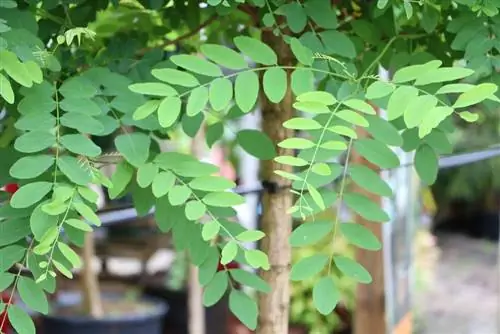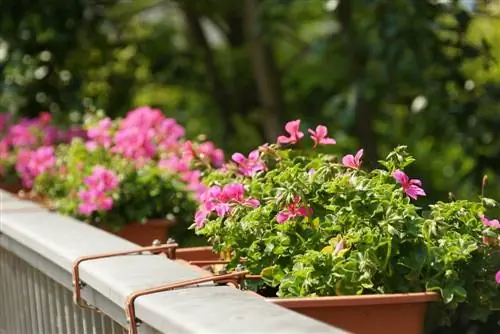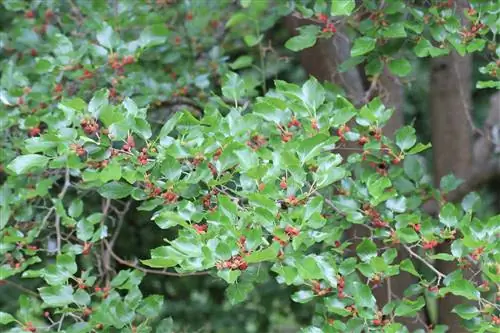- Author admin [email protected].
- Public 2023-12-17 03:39.
- Last modified 2025-06-01 06:48.
Black elderberry grows as a heavily branched 7-10 m high shrub or small tree. It has very good frost hardiness. Its branches grow arching and spreading. From June to July, the white or slightly yellowish, flat, umbrella-like inflorescences appear, which consist of many individual flowers and exude a fresh, fruity scent. The approximately 6 mm large berries (drupes) of the black elderberry, which ripen between August and September, are initially red and later turn black.
Profile
- Botanical name Sambucus nigra.
- Belongs to the muskweed family.
- Reaches heights of up to 10 m.
- Strikes out strong and fast.
- Flowers are hand-sized, umbrella-shaped umbels.
- Flowering period from June to July.
- Flower color white to slightly yellowish.
- The so-called drupes form after flowering.
- Bark, leaves, seeds and unripe berries are poisonous.
Plants
If you want to plant an elderberry, you should choose a location where it can spread unhindered. Black elderberry can be planted in early spring or fall, although spring planting is more recommended. If it has already sprouted when planted, these shoots should be cut back heavily, otherwise it will neglect root formation and therefore grow more poorly. From April onwards, bare-root produce in particular should no longer be planted; rising temperatures could cause the new shoots to wilt. The planting hole should be about twice as large as the root ball. Before planting, add plenty of compost and horn shavings to the planting pit. After the plant has been planted and filled with excavated soil, it must be watered abundantly. It is best to create a watering edge around the root area so that the water stays where it is needed. If there are several specimens, a planting distance of at least four meters must be maintained. This means that the elderberry has enough space to spread both underground and above ground.
Tip:
Planting next to a compost heap is particularly recommended, as this provides it with sufficient nutrients. It is also good to line the planting hole with nettle leaves.
Watering and fertilizing
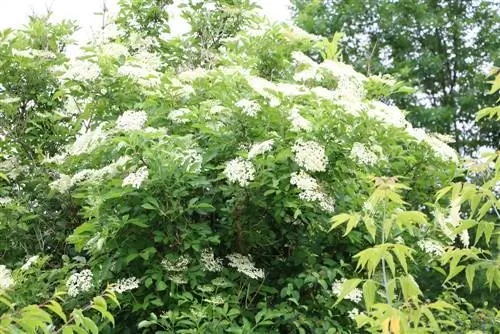
In the first three weeks after planting, you should water daily and abundantly so that the plants grow better. This applies equally to bare root and container goods. To keep moisture in the soil for longer, it is recommended to apply a layer of mulch made from leaves or grass clippings. Later, normal amounts of rain are sufficient; additional watering is only advisable during longer periods of heat and dryness. If plenty of compost and horn shavings were incorporated into the soil during planting or the elderberry was planted in the immediate vicinity of a compost heap, further fertilization can be dispensed with. If the soil is particularly poor, additional fertilization is required. In contrast to other types of fruit, elderberry requires nitrogen-based fertilization. Accordingly, from the beginning of budding to the end of flowering, fertilization should be carried out 2-3 times with plant manure, for example nettle manure. This nitrogen-based fertilization must be stopped when fruit sets begin.
Care and cutting
When pruning, it is advisable to grow a tree with 3-5 flat leading branches from which 13-15 young shoots are grown per year, because black elderberry generally grows on annual wood. Side shoots and flowers develop here in spring. Pruning should be carried out when planting, limiting the tree height to around one meter. If the plant already has sufficiently strong branches at this time, these can be cut back to around two pairs of buds each. In the following years, the number of remaining shoots is increased bit by bit until a final number of young shoots of 13-15 is reached in the fourth year. These pruning measures should be carried out during winter pruning. Since the elderberry usually develops more shoots than it needs year after year, it makes sense to cut it regularly in spring or summer so that it can rejuvenate. All weak shoots that grow too steeply and too strongly as well as all excess shoots that are too far out are removed.
Location and soil requirements
- As far as location is concerned, Sambucus nigra is rather undemanding.
- It thrives equally well in sunny and partially shaded locations.
- It is also very shade tolerant.
- However, it should not be planted too close to other plants.
- Elderberry is very competitive.
- The soil should be free of stagnant moisture and rich in nutrients.
- It should also be permeable, deep and rich in humus, with a pH value of 6.5.
- Sandy loam soils are ideal.
Tip:
Black elderberry is a native tree and is therefore hardy. It also tolerates extreme temperatures below zero, so no winter protection is required.
Diseases and pests
Umbel wilt - Fusarium infestation on an elderberry umbel
As a rule, the lilac berry is relatively robust. Despite everything, disease or pest infestation can occur depending on the weather and location. Umbel wilt is manifested by wilted umbels as well as premature ripening and dropping of the fruits. There may be reddish to yellowish leaf spots on the edges of the leaves, which later become larger and ultimately dry out. Infected wood should be removed during winter pruning so that the elderberry is better ventilated and dries faster. Susceptibility can be significantly reduced with generous potash fertilization in spring. Plant-strengthening agents can also be helpful, such as the homeopathic preparation Biplantol, with which you treat the plant 2-3 times.
Colletotrichum fruit rot
This fungal disease can be recognized by shrinking and wilting berries on which a salmon-like coating forms. Infected plant parts or fruit mummies should be removed during winter pruning. In addition, it can be treated with suitable pesticides. The individual treatments should be carried out before and during a rainy period. Regular thinning cuts can counteract fruit rot.
Gray horse
Grey mold mainly occurs during flowering and in damp weather. It is evident from a gray fungal mycelium that covers the fruit umbels. The earlier the infestation is detected and treated, the higher the chances that the plant will recover completely. First, all affected plant parts are removed and disposed of and then treated with a suitable fungicide. As a preventive measure, regular thinning is also recommended here.
elderberry aphid
The elderberry aphid appears on young elderberry shoots in April/May and leads to deformed leaves and flowers. Infected shoot tips are removed. In addition, sprays containing the active ingredients pyrethrin or azadirachtin A can be used.
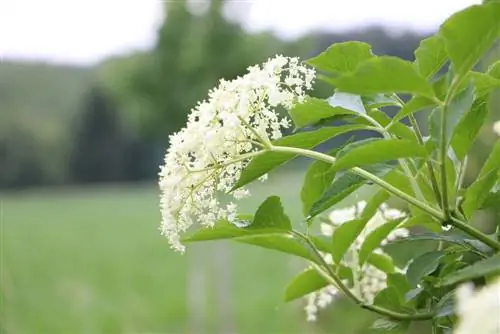
Conclusion
Black elderberry is not only a visual highlight in the garden when it is in bloom, its shiny black berries are also very decorative and versatile. And if you pay attention to optimal site conditions and thin out the plants annually, disease and pest infestation can also be effectively prevented.

